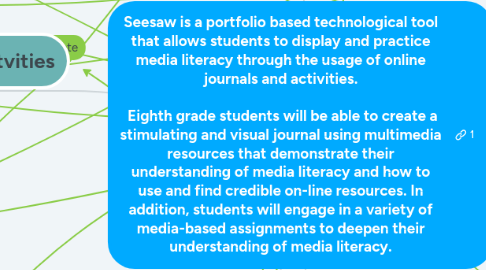
1. Learning Actvities
1.1. Watch: What is Media Litereacy, Fake News: NBC News, and How false new can spread by Noah Tavlin.
1.1.1. Read: What is media literacy, and why it is important, 4 tips for spotting fake news story, and finding Reliable Sources: Criteria for Evaluating Reliability
1.2. Watch: Fake News: How a Partying Macedonian Teen Earns Thousands Publishing Lies, NBC News
1.2.1. Do Activity: Journal on Seesaw
1.3. Watch video: Digital Media Guided Analysis
1.3.1. Read Article: Texas Man Freed After Outliving 99-Year Prison Sentence for Horse Theft
1.3.1.1. Do Actvity: Complete Guided Analysis Worksheet: Analyzing an Article - Compare and Contrast
1.4. Read: Credibility Checklist
1.4.1. Read: Three Instructor-Selected Resources
1.4.1.1. Do: Evaluate the Three Provided Sources Using the Checklist and Ranks them in order of Credibility
1.5. Do Actvitiy: Curate at least 5 reliable sources
2. Learning Assessments
2.1. Formative
2.1.1. Instructor Observes Students Accessing Technology and Provides Process Feedback
2.1.2. Instructor Evaluates and Provides Feedback on Student Journal Post on Seesaw that Analyzes an Article and Video
2.1.3. Instructor Evaluates and Provides Feedback on Student Journal Post on Seesaw that Explains Student Rationale for Trusting or Not Trusting a Source
2.2. Summative
2.2.1. Instructor Evaluates a Student Media Post on Seesaw of a list of 5 Sources a Student Deems Credible
3. Student Roles
3.1. Students will use on-line resources to identify credible sources
3.1.1. Create and Post on Seesaw Journals and Activities
3.2. Learn Actively
3.2.1. Read to Analyze
3.2.1.1. Students will analyze given assignments by using classroom knowledge and utilize Seesaw resources to effectively process and analyze news sources.
3.2.2. Read to Evaluate
3.2.3. Curate Resources
3.2.3.1. Curate original resources to display understanding of how to find and use credible news sources.
3.3. Use Effective Research Strategies
3.4. Evaluate Resources
3.4.1. Evaluate resources for credibility by using learned skills through provided activities from instructor
3.5. Demonstrate learning through usage of multimedia through journal posts, reading, watching selected videos, and activities.
4. Teacher Roles
4.1. Instructors have the ability to approve and provide feedback to student responses on journal post.
4.1.1. Facilitate
4.2. In order to facilitate new learning experiences instructors can create activities, post select videos, and implement reading sources.
4.2.1. Guide students
4.2.1.1. Activities centered around how to effectively use multimedia in digital spaces, reflective problem solving writing, and complex critical reasoning scenarios in finding credible on-line resources.
4.3. Review Student Content and Assess
4.3.1. Grade actvities
4.3.2. Instructors are able to monitor and track students' media literacy and classroom knowledge by using Seesaw's skill scale. The skill scale can identity potential or present problem areas for students. In addition, skill scales can also monitor students' success by keeping a digital record of student graded assignments based on instructor customized grading scale. For this particular assignment, the instructor can measure if the student is able to correctly identify reliable on-line resources.
4.4. Teach a Review of "Skills" in Seesaw
4.4.1. Support students
4.4.1.1. Skills Rating Scale
4.4.1.2. Instructors are able to provide constructive and uplifting feedback for students to view and share work with students' guardians, who can also comment.
5. Learning Goals
5.1. Through the usage of on-line tools students will demonstrate that they can find and access credible on-line resources.
5.1.1. Google Scholar
5.1.2. Infotopia
5.1.3. Science.gov

